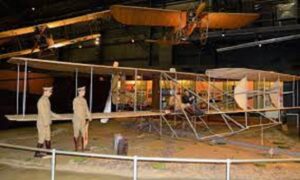Doctor Curmudgeon® The 1909 Military Flyer
By Diane Batshaw Eisman, M.D. FAAP Doctor Eisman is in Family Practice in Aventura, Florida with her partner, Dr. Eugene Eisman, an internist/cardiologist
What a rude awakening!
The time: Sunday afternoon.
The Scene: The Curmudgeon Family Home.
I had merely dozed off in the living room, a book nestled peacefully in my lap when…
Crash!
Glass shards hitting the floor.
Shrieking, mewing and kittenish giggling.
What else could it be? Of course, my exuberant kitten cousins, who were spending the weekend with us.
After cornering the mischievous duo, it turned out that they had been studying the origins of flight and had decided to emulate the Wright Brothers by leaping from pieces of furniture. This was their version of flight and they wanted to see which imp could remain in the air the longest.
Their research did have a positive effect. An ugly, expensive vase had met its demise. It had been a gift from an aunt who had a habit of appearing rather spontaneously at odd times.
Their school project had completely fascinated the kittens. After listening to their essays on flight, I had become equally intrigued.
The Army Signal Corps had been looking for a plane that could remain in the air for at least one hour, hold two people, and land easily without harm to the occupants or the plane. It also had to be effortlessly taken apart and put back together so it could be moved around on an Army vehicle. Additionally, this plane had to be so easy to pilot that someone could quickly become skilled.
In 1909, the Wright Brothers presented the United States Army with the first military airplane. The 1909 Wright Flyer was accepted officially on August 2, 1909 and became Signal Corps Airplane No. 1.
The plane was a wooden bi-plane. Its 30-40 horse power four-cylinder engine used sprockets and chains to move two wooden propellers.
Lieutenant Frederick E. Humphreys became the first military pilot when he soloed on October 26.
And after lieutenant Humphreys landed, Lieutenant Frank Purdy Lahm flew the plane.
Not long after their successful flights, both Lieutenant Lahm and Lieutenant Humphreys returned to their own units.
Now, the United States army found itself with one solitary airplane, a few mechanics and no pilots.
Along came Lieutenant Benjamin Foulois. He had been a passenger on a few occasions in the plane. Because of his “experience,” he received orders to teach himself to fly the plane and get it to Fort Sam Houston in Texas.
Graciously, the Wright Brothers mailed him flying instructions. And so, his maiden flight was on March 2, 1910. Before this he had never soloed. Astoundingly, he had never even landed a plane or taken off in one.
Both he and the plane survived.
It is not surprising that, eventually, Lieutenant Benjamin Foulois was promoted to General.
And what was the bill to the Army for this fabulous first military plane?
Thirty thousand dollars!
Dr. Curmudgeon suggests “Bitter Medicine”, Dr. Eugene Eisman’s story of his experiences–from the humorous to the intense—as a young army doctor serving in the Vietnam War.
Bitter Medicine by Eugene H. Eisman, M.D. –on Amazon
Doctor Curmudgeon® is Diane Batshaw Eisman, M.D., a physician-satirist. This column originally appeared on SERMO, the leading global social network for doctors.
SERMO www.sermo.com
Click Here to Order Boxing Interviews Of A Lifetime By “Bad” Brad Berkwitt


